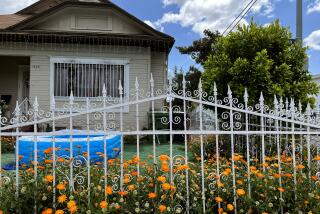Changes Made in Way Houses Built : Construction Differs from the Post-World War II Era
NEW YORK â Like Cary Grant and Myrna Loy in the film, âMr. Blandings Builds His Dream House,â thousands of American families each year buy brand-new homes, some of them custom built.
But todayâs home buyers are finding that they donât build houses in quite the same way or with quite the same materials used at the time of that 1948 film.
The construction and design of new homes has undergone an evolution since the post-World War II building boom, although the changes may not be readily apparent as you drive down a suburban street through a development of new houses.
The changes tend to be subtle, like different uses of space both inside and out, or different kinds of materials used to build the house.
The biggest change from a builderâs point of view is the move toward prefabrication, where components of the house--ranging from parts of the roof to entire sections of a home--are assembled in a factory and then shipped to the building site.
âWeâre using a lot more pre-built components even in stick-built homes, ones built from scratch,â said Martin Mintz, director of technical services for the National Assn. of Home Builders.
Two Types of Homes
He noted that in most homes built today, roof trusses--2-by-4-inch pieces of lumber put together to form triangular sections of a roof--are used.
âThey wonât be setting individual rafters, just slipping the triangular pieces in place,â Mintz said.
Two types of prefabricated housing that are gaining acceptance are panelized and modular homes.
In a panelized house, entire sections of walls, floors and roofs are assembled in a factory and taken to the site. Interior and exterior walls, electrical and plumbing work included, can be put together to form one unit.
In Bedford, N.Y., developer Jad Barghout has used panels to form the exterior walls of 26 town houses he is building on a wooded hillside near a commuter train station in the New York City suburb.
Windows and doors were set into the panels and insulation was attached at the factory. The panels are joined together with seams, but as you look over the outside of a finished home, itâs impossible to tell where they are joined or even to detect that sections of the walls arrived at the site already constructed.
Faster Construction
Prefabrication often allows a house to be built faster, which can translate into cost savings.
Barghout says the exteriors of his houses, including roofs, were completed in 10 days, compared with 30 days for a stick-built home. The money he saved was channeled into more amenities to make the houses more attractive to buyers.
Delays from snow and rain are minimized because housing components are built âin a controlled environment with the least amount of weather exposure,â said Nancy Smith, a spokeswoman for Ryland Group Inc., a manufacturer of panelized and modular housing.
And by using prefabricated materials, builders can cut down on the number of subcontractors to complete a job.
While prefabrication saves money, builders say itâs hard to determine how much of the savings is passed on to home buyers. Factors such as shipping of materials over long distances and the varying cost of land from one region to another may make a prefabricated house as expensive as a stick-built home.
In modular homes, segments of the house are produced in the factory, complete with fixtures, carpeting and even paint on the walls. Modular homes are 95% complete when they leave the factory.
Ordered in Showroom
Modular and panelized homes can be ordered in showrooms, with amenities added in much the same way a buyer selects options for a new car.
âYou can add this, that or the other, upgrading the basic model,â said Linda Parrish, assistant director of the Building Systems Councils--a part of the NAHB.
Some modular home manufacturers produce standard units, with little flexibility in design. Other manufacturers can produce two-story or split-level homes, and add porches, patios and dormer windows.
Many of these changes in home construction reflect shifts in the demographics of home buyers--in particular, the entry of the baby-boom generation into what is known as the move-up housing market.
The town house and condominium developments popular in many areas were ideal for first-time buyers of the 1980s, said Ara Hovnanian, executive vice president of Hovnanian Enterprises Inc.
Now, âas 1990 approaches, a lot of these first-timers are maturing, and becoming move-up buyers,â he said.
Today, the move-up market tends to consist of detached, one-family houses or more luxurious condos, Hovnanian said.
More Amenities
Move-up houses also have many more amenities. âThereâs more attention to the aesthetics, like master bedrooms that are grander, and larger and more sumptuous baths,â he said.
As life styles and income brackets have changed, so have the space configuration of houses.
Inside, many families are foregoing separate dining rooms and combining a dining area into the living room because they donât want space with a limited use, Mintz said.
âWeâre beginning to see more cathedral ceilings and large, open spaces,â Hovanian said.
Outside, there are different ways of placing a house on a particular piece of land.
Traditionally, houses have been set in the middle of a lot, with strips of land five to eight feet on either side. But builders now place some homes directly on property lines, freeing up 10 to 16 feet of more usable space on one side, Mintz said.
âWeâre seeing homes being built on smaller pieces of property, especially where the cost of land has become unconscionable,â Mintz said, but added, âThereâs more innovative design when itâs smaller.â
Use Less Energy
The builders say that although todayâs houses may be getting bigger, they are easier to heat and cool--a legacy of the oil embargo in the 1970s.
âA house built today uses 50% less energy than ones built five or six or seven years ago,â Mintz said, noting, âThere are much more efficient furnaces that use less fuel.â
More homes are insulated, and in cold climates, thermal-paned windows are popular.
The homes being built by Barghout have insulation in the walls, roof, basement and between floors. Triple-paned windows and doors were installed.
The basic building materials have not changed much over the years--builders still need roof tiles, nails and plaster walls--but there have been some innovations.
In some areas, steel is used instead of lumber for wall studs, Mintz said. However, he said, 2-by-4s--the building blocks of the Blandingsâ dream house and perhaps the strongest link to homes of the past--are still the norm in most of the country.
More to Read
Sign up for Essential California
The most important California stories and recommendations in your inbox every morning.
You may occasionally receive promotional content from the Los Angeles Times.






